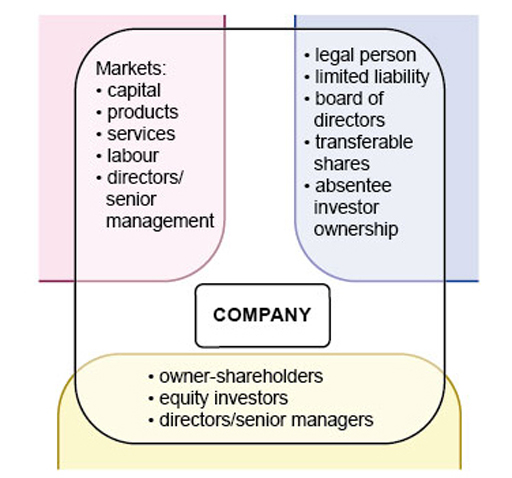1.4.5 Absentee investor ownership
Modern portfolio investment is generally based on an assessment of the risk of a company in comparison with the risk of its peers and the return on their investment (that is dividends and the increase in the share price). Portfolio investors, including institutional investors such as investment trusts and pension funds, regularly balance their investment portfolios based on these two characteristics.
Speculators make decisions to hold and sell shares based on the movements in share prices. A speculator deals in financial assets with a view to making a quick profit from favourable price movements. This is a little like betting which assets will go up in price and which will go down. Short-term investors and speculators have no incentive at all to monitor the directors because if they don’t like what they see, they will simply sell their shares.
The five legal characteristics of the modern corporation discussed above are shown in the blue (law) part of Figure 4 below.
In Section 2 you will learn about markets, and especially about the company’s need to raise equity capital and loan capital on capital markets.
Activity 2 The modern corporation
The purpose of this activity is to understand the characteristics of private limited companies, public limited companies and quoted or listed public limited companies.
Think about answers to the following question:
Among private limited companies, public limited companies and quoted public limited companies, which is more likely to have all five characteristics of ‘the modern corporation’?
Feedback
A small private limited company with only a few shareholders is likely to have only two of the five characteristics of the modern corporation: legal personality and limited liability.
A large private company with many shareholders is likely to have a centralised delegated board of directors.
A small public limited company will have at least three characteristics because its shares are transferable, but a larger company is also likely to have a delegated board of directors.
Only a listed or quoted public limited company will have all the characteristics of the modern corporation.
| HighlightedPrivate limited company | HighlightedPublic limited company | HighlightedQuoted public limited company |
|---|---|---|
| Legal personality | Legal personality | Legal personality |
| Limited liability | Limited liability | Limited liability |
| If small: owner-directors | If small: owner-directors | Delegated board of directors |
| Permission to sell shares | Transferable shares | Freely tradable shares |
| Shareholder ownership | Shareholder/investor ownership | Absentee investor ownership |
Activity 3 Single-entity companies
The purpose of this activity is to understand that single entity companies are more likely to be small or medium-sized private limited companies or public limited companies.
Which type of company is most likely to be a single-entity company?
Feedback
Private limited companies are often smaller than public limited companies. Therefore private limited companies and very small public limited companies are more likely to be single entity companies, although there are exceptions. In the UK, companies are often organised as groups. Learning to prepare and interpret group accounts is outside the scope of this course.

